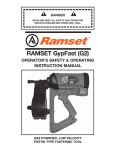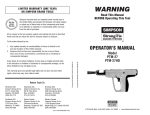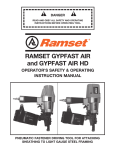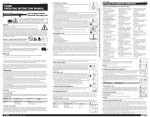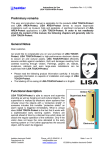Download RAMSET TF1200 Operating instructions
Transcript
DANGER READ AND OBEY ALL SAFETY AND OPERATING INSTRUCTIONS BEFORE OPERATING TOOL. RAMSET TF1200 TOOL SYSTEM OPERATOR’S SAFETY & OPERATING INSTRUCTION MANUAL GAS POWERED, LOW VELOCITY PISTON TYPE FASTENING TOOL SAFETY INTRODUCTION DANGER DANGER THIS TOOL IS TO BE USED ONLY BY PROPERLY TRAINED OPERATORS. ATTEMPTING TO HANDLE OR OPERATE THE TF1200 GAS POWERED TOOL WITHOUT PROPER TRAINING CAN RESULT IN SERIOUS INJURY TO THE OPERATOR OR BYSTANDERS. ! Read, understand and follow the instructions in the tool manual before attempting to use the tool. ! Operators and Bystanders must wear eye and hearing protection. ! Never close tool with hand over the fastener loading end of the tool. A serious hand injury from penetration by the piston or fastener could result. ! The gas in fuel cells is under pressure and the gas is flammable. ! Do not open, puncture or burn fuel cells. ! Store fuel cells in a well ventilated area, at temperatures below 50° C (122° F) and out of the sunlight. ! Keep fuel cells away from flames, sparks and heat. ! Do not attempt to recharge, refill or recycle fuel cells. ! Never operate the TF1200 tool if flammable or explosive materials are nearby. DANGER Just as no one can merely read a book about driving an automobile and then hope to drive one safely, no one should attempt to use TF1200 gas powered tool without adequate, competent personal instruction. No automobile instruction book or instructor can forewarn a learner against all possibilities and emergencies, nor can printed material detail all possible conditions surrounding the use of Ramset tools and products. Responsibility for the safe and proper use of this tool rests with the tool user and the employer. SAFETY INTRODUCTION 2 DANGER DANGER SAFETY INSTRUCTIONS Preparation For Fastening Acceptable Base Materials The gas powered TF1200 tools is suitable for use in the following base materials only: • Poured Concrete Solid Concrete and Precast Concrete • Structural Steel • Concrete Block and Horizontal Joints in Brick or Masonry Walls Never attempt to fasten into any other type of material. Fastening into other materials can cause blindness or other serious injury. Never attempt to fasten into very hard or brittle materials such as cast iron, tile, glass, or rock of any type. These materials can shatter, causing the fastener and/or base material fragments to fly free and cause serious injury to the tool operator and others. Never fasten into any base material that does not pass the Center Punch test. Failure to assure the suitability of the base material can result in serious injury to the eyes or other body parts. Center Punch Test ALWAYS WEAR SAFETY GOGGLES WHEN PERFORMING THIS TEST. 1. Always check the material being fastened into for hardness before attempting any fastening operation. 2. Using a fastener as a center punch, strike the fastener against the work surface using an average hammer blow and check the results. DANGER Structural Steel Solid or Hollow Block Horizontal Joints only in Brick Walls Center Punch Test Results 1. If the fastener point is flattened, the material is too hard for a powder actuated fastening. 2. If the fastener penetrates the material easily, the material is too soft. 3.If the material cracks or shatters, the material is too brittle. 4. If the fastener makes a small indentation into the material, the material is suitable for fastening. SAFETY INSTRUCTIONS 3 FASTENING APPLICATIONS 3" MIN. FASTENING APPLICATIONS Your TF1200 tools can be used for a wide range of fastening needs in a variety of base materials. Reading and following these important fastening guidelines will help you get the best results from your tool and fasteners, as well as help you perform these fastening operations safely and effectively. TF1200 fastenings are permanent fastenings so attempting to remove a fastener from concrete or steel may result in a serious injury. 3" MIN. SPACING - THIN GAUGE METAL TO CONCRETE 3" MIN. 3" MIN.3" MIN. Fastening to Concrete When fastening into concrete, always maintain a minimum spacing of 3” between fastenings and 3” from any free edge. Concrete thickness should be at least three times the intended penetration depth into the concrete. Driving fasteners too close to an edge or too close to each other can cause the concrete edge to fail or fasteners to fly free. Fastening to Concrete Block or to Masonry Walls 3" MIN. SPACING - THIN WOOD STRIP TO CONCRETE 3" 1/2" MIN. 1/2" MIN. Take care to observe a 3” edge distance to avoid cracking the block and over penetration of the fastener to avoid a loss of holding value. Fastenings may also be made into the horizontal joint but not into the vertical joint. Fastening to Steel Your TF1200 tools can be used for fastening on the flat surfaces of structural steel. When fastening into steel, always maintain a minimum spacing of 1-1/2” between fastenings and 1/2” from any edge. FASTENING APPLICATIONS 4 MIN. 1-1/2" MIN. 1-1/2" MIN. SPACING STEEL TO STEEL WARNING! 3" MIN. NEVER FASTEN INTO INAPPROPIATE BASE MATERIAL. Materials such as hardened steel, the web or edge of an I-beam, or steel that is too thick may cause the fastener to bend and or break and could cause serious injury. Ramset performance data offers a guideline of appropriate base materials and thicknesses. 1/2" MIN. 1-1/2" MIN. DANGER SAFETY INSTRUCTIONS FAILURE TO FOLLOW INSTRUCTIONS CAN CAUSE INJURY TO THE TOOL OPERATOR OR TO BYSTANDERS. • Use the tool only in well ventilated areas. Ceilings Walls • Always hold the tool at right angles to the work surface. • Never attempt to make a fastening at an angle to the work surface. • While the tool can be used in any position (floor, wall or ceiling) it is important to have both the nose of the tool and support foot in contact with the work surface to minimize spall and make the best quality fastenings. Floors The TF1200 tools may be used in any position. • Do not press down on the nose of the tool until just before you intend to make the fastening. • Never place your hand or any other body part over the fastener end of the tool. • Never carry the tool with your finger on the trigger. • Never leave the tool unattended or allow anyone to operate it without first being trained. 90° Keep both the nose of the tool and support foot in contact with the work surface and hold tool perpendicular to the work surface. • Never engage in horseplay with the tool. • Always keep the tool pointed away from yourself or others. • Never operate the tool if explosive or flammable materials are nearby. • Keep the tool and supplies locked up and out of the reach of children. DANGER Keep tool locked up and out of reach of children SAFETY INSTRUCTIONS 5 BATTERY CELL AND CHARGING SYSTEM BATTERY CELL AND CHARGER CHARGING INSTRUCTIONS The first step in preparing a new tool for operation is to fully charge the new Battery. New Batteries are shipped discharged and must be charged for 24 hours before first use. All subsequent charges will require at most a 3 hour charge. 1. Connect the round plug of the wall mount unit to the front of the charger base and plug the wall mount unit into any 120V AC outlet. A LED by the plug indicates the base unit has power. WARNING Important Charging Notes CHEMICAL/ EXPLOSION HAZARD Read ALL instructions before charging or using battery. Failure to follow ALL instructions may result in fire, severe burns, or release of toxic materials. Battery Disposal: The EPA certified RBRC® Battery Recycling Seal on the nickel-cadium (Ni-Cd) battery indicates Ramset is voluntarily participating in an industry program to collect and recycle these batteries at the end of their useful life, when taken out of service in the United States or Canada. The RBRC® program provides a convenient alternative to placing used Ni-Cd batteries into the trash or the municipal waste stream, which may be illegal in your area. Please call 1-800-8-BATTERY™ (1-800-822-8837) for information on Ni-Cd battery recycling and disposal in your area. Ramset’s involvement in this program is part of our commitment to preserving our environment and conserving our natural resources. Holds both Ramset stick and New TF1200 Battery 2. Set the charger base on a stable surface and insert the battery or batteries, contact first, into the opening of the charger base. 3. The TF1200 charger incorporates a charge level indicator to inform the user of the battery charge level. A red light will illuminate at all times during a charge cycle. One green light = battery at 50% capacity Two green lights = battery at 75% capacity Three green lights = battery at FULL capacity The red light will not be lit when the battery is at full charge. CHARGING DONT’S • Do not charge battery when temperature is below 40°F (5°C). • Do not drop battery or charger. • Do not allow metal objects to come in contact with battery terminals. • Do not puncture or attempt to open battery case or cells. • Do not store battery where it will be subjected to temperatures above 120°F (49°C). • Do not incinerate battery. • Do not use a defective battery charger, one that overheats and/or smokes when plugged in. Ramset Battery Charger BATTERY CELL AND CHARGING SYSTEM 6 INSTALLING THE BATTERY INSTALLING THE BATTERY #1 • Insert the battery into the tool as shown on the right with the clip facing out. • The battery has two positions in the tool: 1.The “OFF” position—as shown in picture #1 to the right. 2.The “RUN” position—as shown in picture #2 to the right. • To operate the tool be sure the battery is fully inserted into the tool. After installing the battery, note the LED light on the right side of the handle. OFF NOTE: OFF position shown in small window #2 • If the light flashes green, the tool is powered. • If the light flashes red, the battery requires charging. • If the light is solid green and the fan is running, the tool is ready to take the next shot. • If the light is solid red and the fan is not on, the battery needs to be recharged. • If the tool will not be used for a short period of time, click the battery back into the “OFF” position. This will prevent the tool from being fired. • If the tool will not be used for extended periods of time, remove the battery and store in the tool case. RUN NOTE: Battery fully inserted into tool #3 NOTE: LED Light INSTALLING THE BATTERY 7 FUEL CELL AND METERING VALVE Fuel Cell DANGER EXPLOSION/FIRE HAZARD Read ALL safety instructions before using or handling the fuel cell. Failure to follow ALL instructions may result in explosion or fire. This may cause severe personal injuries or property damage. Keep the fuel cell away from heat, sparks and open flame. Exposure to temperatures above 120°F (49°C) may cause the fuel cell to burst, releasing flammable gas. To eject the fuel, propellant pressure squeezes the inner fuel container, much as you squeeze a tube of toothpaste. This squeezing action ensures that all the fuel is used, and that the TF1200 tool can operate in any position. Because of this container-within-a-container design, you might hear the sound of fluid when shaking the fuel cell after all the fuel has been used. This is the propellant, which remains between the containers even after all the fuel has been expelled. If you expose the empty fuel cell to extreme temperatures, the propellant gas will expand and could cause the container to burst, releasing flammable gases. Metering Valve The metering valve contains a fuel metering system to inject the correct amount of fuel into the combustion chamber. The red metering valve is the only valve that will operate properly with the TF1200 tool. WARNING • Sunlight can raise the inside temperature of an unventilated car or van to above 140°F (60°C). • Do not puncture or attempt to open the fuel cell; it is non-refillable. • Do not incinerate, reclaim or recycle the fuel cell. • Do not smoke while installing or removing the metering cell. • Do not inhale the spray. • Keep out of the reach of children. • Store fuel cell(s) in well-ventilated areas only. • Do not reuse metering valve. NOTE: 1. Do not attempt to reuse the metering valve! Replace with fresh fuel cell/valve, and dispose of spent cell/valve properly. 2. When replacing fuel cell also clean or replace air filter for optimum tool operation. Attaching Metering Valve to Fuel Cell To attach the metering valve to a fuel cell: 1. Press downward on the front side of the valve (stem side) until it seats. 2. Press downward on the rear of the valve unit it seats. 3. The valve is now completely seated on the fuel can and can be inserted into the tool. There is a second container inside the fuel cell. The inner container holds the fuel. The space between the inner container and the outer cylinder is filled with a gas, called the propellant, which is under pressure. FUEL CELL AND METERING VALVE 8 FUEL CELL AND METERING VALVE INSERTING FUEL CELL leads to the Combustion Chamber. Insert the Metering Valve Stem into the orifice of the red colored Adaptor. You complete the loading of Fuel in the TF1200 tool by closing the Actuator Cover. You do this by swinging it up and over the Fuel Valve/Cylinder Assembly and pushing down until the Actuator Cover snaps into position. With the Metering Valve Stem pointed toward the front of the tool, insert the Metering Valve/Fuel Cell Assembly. OUTDOOR WEATHER AND THE TF1200 TOOL Use the TF1200 tool outdoors, in clear weather, when the Tool, Fuel Cell, and Battery are between 20°F (-7°C) and 120°F (49°C). Colder temperatures may damage the TF1200 Tool and Battery Cell. Hotter temperatures may damage the Tool and Fuel Cell. Fuel should be stored out of direct sunlight in surroundings less than 120°F (49°C). After extended periods of continuous use, cool the Tool by running the Fan Motor. Operation when the Tool is less than 20°F (-7°C) may damage the tool. Fuel Cells at cold temperatures lose the required propellant force. Bring the Tool, Battery Cell, and Fuel Cell above minimum operating temperature without direct exposure to flame, and check the Battery. As you slide the Metering Valve/Fuel Cell Assembly into the TF1200 tool, you will notice that there is a Red Adaptor at the top of the Cylinder Pocket. As is shown in the illustration, this Adaptor is designed to ensure that the Metering Valve Stem is properly aligned with the small hole, or orifice that CAUTION The TF1200 tool should not be used in the rain or where excessive moisture is present. These conditions may result in damage to tool components and cause tool to malfunction. FUEL CELL AND METERING VALVE 9 TF1200 MAGAZINE TOOL OPERATING INSTRUCTIONS TOOL OPERATION Always check the tool first to make sure that it does not contain a fastener. If the tool contains a fastener from a previous application, remove both the battery and the fuel cell before attempting to remove the fastener. Insert battery Operating the TF1200 Tool 1. Insert a charged battery into the tool with the battery clip facing out. 2. Insert the Ramset fuel cell into the tool as described on page 9. 3. Pull the magazine follower back to the locking position. Insert fuel cell 4. Insert the nail strips into the opening in the back of the magazine. 5. Slightly pull back on the magazine follower while pressing the button at the back of the follower. This will release the follower making contact with the back of the last pin strip. 6. Place the tool in the spot where you want to make the fastening. 7. With the tool in position and perpendicular to the work surface; press down on the tool. 8. Note that the fan motor is running and the LED light on the side of the handle is a solid green color indicating the tool is ready to make a fastening. 9. Pull the trigger to make the fastening. Insert fasteners Hold tool perpendicular in contact with work surface 90° 10.The tool is ready for the next fastening. To avoid overheating the tool do not hold your hand over the air intake section on the top end of the tool. Knob Removing The Fastener Magazine On occasion the fastener magazine may need to be removed to clear a fastener jam. To do so, unscrew the knob partially to allow the magazine assembly to slide freely. TF1200 MAGAZINE TOOL OPERATING INSTRUCTIONS 10 SERVICING / TROUBLESHOOTING SYMPTOM POSSIBLE PROBLEMS SERVICE Preparing Tool for Operation—Battery/Charger Problems —Battery Cell does not —Inoperative indicator —Try Battery Cell in tool after 3 hours appear to accept lights on charger on charge cycle. If tool LED is charge. Green charger green, charger lights are not light does not come on working properly. Replace charger, or monitor charging time to ensure Battery Cell has adequate time for recharging. It’s normal for Battery to feel warm after properly charging. —Battery Cell damaged —Replace Battery Cell or cycle life exhausted —Damaged charger —Discontinue use immediately and unplug from power source. Replace charger and tag or dispose of charger to prevent accidental reuse or connection to power source. —Flashing lights on —Damaged Battery Cell —Replace Battery charger base unit —Battery Completely —Allow battery to charge for Drained 5 minutes Normal Stage of Operation —Fan does not run —Battery in off position —Fully insert Battery —tool LED is off —Battery Cell is —Charge Battery Cell according to not charged Operating Manual. —Battery terminals or —Clean Battery Cell terminals. battery contacts are Battery Cell contacts as required. oily, dirty, or corroded —Fan does not run, —Battery Cell is or runs slower than discharged normal—tool LED is red —Charge Battery Cell —Fan does not run, —Possible electronics —Remove, reinsert the Battery tool LED flashes error Contact Authorized Ramset red/green Distributor Sales Representative for service. Pre-Combustion/Combustion Stage of Operation —Work Contacting —Work Contacting —Remove and inspect Work Contact Element does not Element is bent, or Element. Repair or replace Work depress fully—tool build-up of debris in Contact Element as required. does not operate nose restricts operation — Tool is out of fasteners —Add fastener strip —Tool will not cycle —fan runs, LED is green —Fuel Cell is empty —Replace Fuel Cell —Spark does not occur. —Contact Authorized Ramset Distributor Sales Representative for service. SERVICING / TROUBLESHOOTING 11 SERVICING / TROUBLESHOOTING SYMPTOM POSSIBLE PROBLEMS SERVICE Power/Exhaust Stage of Operation —Tool operates —Battery cell is properly, but fasteners discharged do not drive fully —Charge Battery Cell —Fuel Cell is low —Check Fuel Cell according to Operating Manual and replace as required. —There may be loss of —Press Work Contact Element seal in combustion against workpiece for one minute. chamber Pull trigger. If fastener does not drive, there is a leak that requires service. —Tool operates —Fuel Cell is low —Check Fuel Cell according to erratically or appears Operating Manual to be losing power— tool LED is green —Filter element is dirty, —Remove Filter element and clean causing tool to overheat according to Operating Manual. Use safe cleaning solution to remove stubborn debris. —Tool sleeve is dirty —Clean tool Returning/Purging Stage of Operation —Tool operated and —Built-up dirt and —Remove debris from Nose bore drove fastener, but debris in Nose bore piston did not return to start position —Mushrooming of —Contact Ramset Distributor Piston Tip Sales Representative for service. —Exhaust ports on the —Return tool to Authorized Sleeve are dirty Ramset Distributor Sales or clogged. Representative for service. —Tool sleeve is dirty —Clean tool —Tool does not open —Work Contacting —Clean tool or replace Work after tool fires Element is bent, Contacting Element as required. or tool is dirty If the TF1200 Magazine tool will not operate after following the above service directions, return the tool to an Ramset Distributor Sales Representative for service. SERVICING / TROUBLESHOOTING 12 WARRANTY RAMSET GAS TOOL SYSTEMS WARRANTY AND LIMITATIONS Ramset warrants that new TF1200 Magazine systems power fastening tools, parts and accessories will be free from defects in material and workmanship for the period shown below. TWO-YEAR/50,000 SHOT WARRANTY A two-year/50,000 shot warranty, which ever comes first, will apply to all parts, except those listed below as normal wearing parts, or parts which are specifically covered by an extended warranty. SIX-MONTH/10,000 SHOT WARRANTY A six-month/10,000 shot warranty applies to the following parts, which are considered normal wearing parts: • Bumper • Piston Assembly • Metal Seal Rings • Piston Rings The warranty period is based off of tool build date, determined from the tool serial number. Ramset may extend the warranty time frame from the date of purchase with a qualifying document proving date of purchase. WARRANTY STATEMENT This warranty is void as to any tool which has been subjected to misuse, abuse, accidental or intentional damage, use with fasteners, fuel, battery, or battery chargers not meeting Ramset specification, size, or quality, improperly maintained, repaired with other than genuine TF1200 replacement parts, damaged in transit or handling, or which, in Ramset’s opinion, has been altered or repaired in a way that affects or detracts from the performance of the tool. Ramset MAKES NO WARRANTY, EXPRESSED OR IMPLIED, RELATING TO MERCHANTABILITY, FITNESS, OR OTHERWISE, EXCEPT AS STATED ABOVE and the liability AS STATED ABOVE AND AS ASSUMED ABOVE is in lieu of all other warranties arising out of, or in connection with, the use and performance of the tool, except to the extent otherwise provided by applicable law. Ramset SHALL IN NO EVENT BE LIABLE FOR ANY DIRECT, INDIRECT, OR CONSEQUENTIAL DAMAGES, INCLUDING, BUT NOT LIMITED TO DAMAGES WHICH MAY ARISE FROM LOSS OF ANTICIPATED PROFITS OR PRODUCTION, SPOILAGE OF MATERIALS, INCREASED COST OF OPERATION OR OTHERWISE. Ramset reserves the right to change specifications, equipment, or designs at any time without notice and without incurring obligation. Ramset’s sole liability hereunder will be to replace any part or accessory which proves to be defective within the specific time period. Any replacement part or accessory provided in accordance with this warranty will carry a warranty for the balance of the period of warranty applicable to the part it replaces. This warranty does not apply to part replacement required due to normal wear. WARRANTY 13 FOR TOOL REPAIR SERVICE CONTACT YOUR LOCAL AUTHORIZED RAMSET DISTRIBUTOR OR TO FIND YOUR NEAREST RAMSET TOOL REPAIR CENTER VISIT OUR WEB SITE AT WWW.RAMSET.COM OR CALL 800-241-5640 (CANADA 1-800-387-9692) Concrete Fastening Systems Glendale Heights, IL 60139 800-RAMSET6 (1-800-726-7386) (Canada 1-800-387-9692) www.ramset.com Buy with Confidence... Buy From Your Authorized Distributor AN ILLINOIS TOOL WORKS COMPANY © ILLINOIS TOOL WORKS 2013 PRINTED IN THE U.S.A. Form No. 100228-07/13
























